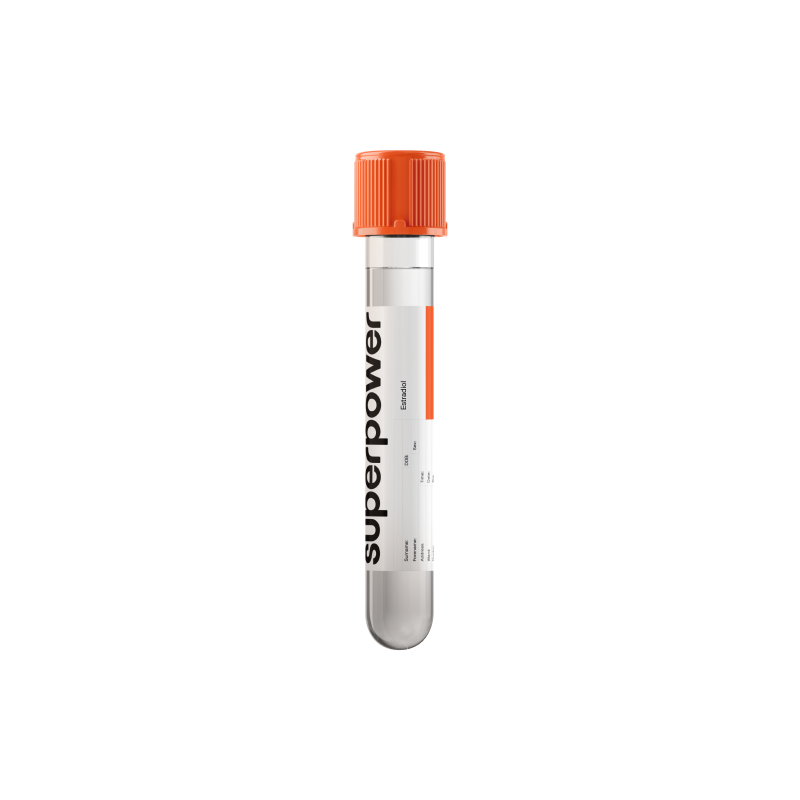Estradiol (E2) is the most potent form of estrogen and influences energy, sexual function, bone health, mood, and cardiovascular protection.
Levels shift with age, cycle phase, body composition, stress, and therapy. Tracking estradiol helps clarify symptoms, guide training and recovery, support fertility, and inform targeted hormone care.
Key Benefits
- Measure estradiol to understand your estrogen status and overall reproductive health.
- Spot hormone imbalance driving irregular periods, hot flashes, or vaginal dryness.
- Clarify ovulation status and fertility potential to guide timing and treatment planning.
- Protect fertility planning by flagging patterns seen with ovarian insufficiency or aging ovaries.
- Guide menopausal or gender-affirming therapy by targeting safe, effective estradiol levels.
- Track hormonal trends across cycles and during assisted reproduction to monitor response.
- Flag unusually high levels that may suggest ovarian, testicular, or adrenal disorders.
- Best interpreted with cycle timing, symptoms, plus FSH, LH, and progesterone.
What is Estradiol?
Estradiol is the body’s principal estrogen hormone (17β-estradiol, E2). It is a steroid made from cholesterol, produced mainly in the ovaries where granulosa cells convert androgens into estrogen via aromatase. Smaller amounts are made in the testes and adrenal glands, and in peripheral tissues—especially fat and brain—through local aromatization. During pregnancy, the placenta becomes a major source. Estradiol is present in all sexes, and its level reflects how actively these tissues are synthesizing estrogen at a given time.
Estradiol is the key signal for growth and maintenance of reproductive tissues. It matures ovarian follicles, builds the uterine lining, shapes cervical mucus, and—through feedback to the brain and pituitary (GnRH, LH, FSH)—helps time ovulation. Beyond reproduction, it preserves bone strength, supports cardiovascular and metabolic functions, influences mood, memory, and sleep, and maintains skin and mucosal integrity. In all sexes, estradiol contributes to libido and normal sperm development (spermatogenesis), making it a broad regulator of cellular growth, repair, and energy use across the body.
Why is Estradiol important?
Estradiol is the body’s principal estrogen—the hormone that sets the tempo for reproduction, bone building, brain signaling, blood vessels, and how we handle lipids, glucose, and salt-water balance. It coordinates growth of the uterine lining, supports fertility, preserves skeletal strength, influences mood and cognition, and modulates vascular tone and clotting.
Reference ranges vary by age, sex, and life stage. In cycling women, levels rise from lower early-cycle values to a midcycle peak, then fall; after menopause they sit low. Men have steady lower levels; children are very low; pregnancy is very high. For most people, wellbeing tracks with the physiologic middle appropriate to one’s sex, age, and cycle phase.
When estradiol runs low, it signals reduced ovarian/testicular production or low aromatase activity—seen with menopause, hypothalamic amenorrhea, ovarian or pituitary insufficiency, or certain medications. Effects include hot flashes, sleep and mood changes, vaginal dryness, lower libido, and bone loss with fracture risk; lipids may shift unfavorably and vessels stiffen. In men, low estradiol contributes to low bone density, joint aches, and reduced sexual function. In teens, values that stay very low can delay puberty.
When estradiol runs high (outside pregnancy), it often reflects increased ovarian production, estrogen-secreting tumors, liver disease, or excess aromatization with higher adiposity. People may notice breast tenderness, bloating, headaches, nausea, and heavy or irregular bleeding; endometrial thickening, fibroid growth, and higher clot risk can occur. Men may develop gynecomastia, reduced fertility, and erectile changes. In children, sustained elevation can drive precocious puberty.
Big picture: estradiol is a readout of the hypothalamic–pituitary–gonadal axis and peripheral aromatase, linking reproduction to bone, brain, metabolism, and the cardiovascular system. Chronically low levels accelerate bone loss and may worsen vascular risk after menopause; chronically high levels increase risks for hormone‑sensitive tissues and thrombosis. Balanced, life‑stage‑appropriate estradiol supports resilience across systems and long‑term health.
What Insights Will I Get?
Estradiol (E2) is the principal estrogen, made by the ovaries and by converting androgens in fat, muscle, and testes. It coordinates reproduction and also tunes bone turnover, vascular tone and lipids, brain circuits for mood and cognition, glucose–insulin balance, and immune signaling.
Low values usually reflect reduced ovarian production (perimenopause/menopause, ovarian insufficiency) or hypothalamic–pituitary suppression; in males, low testosterone or low aromatase conversion. System effects include bone loss, hot flashes, urogenital dryness, lower libido, mood and sleep disturbance, an unfavorable cholesterol pattern, and reduced vascular flexibility.
Being in range suggests appropriate estrogen signaling for age, sex, and physiologic state, supporting stable cycles and ovulation in menstruating adults, maintained bone mineralization, favorable lipid handling, healthy brain blood flow and cognition, and balanced immune tone. For most, optimal sits mid-range for the relevant reference (cycle phase or sex).
High values usually reflect pregnancy, exogenous estrogen or ovarian stimulation, increased aromatization with adiposity, impaired liver clearance, or estrogen‑secreting tumors (e.g., granulosa cell). Consequences can include breast tenderness, heavy or irregular bleeding, migraines, fluid retention, and a prothrombotic tendency; in males, gynecomastia, reduced fertility, and sexual dysfunction.
Notes: Values vary widely by menstrual phase, age, and pregnancy, and many contraceptives or therapies suppress endogenous estradiol. Most assays report total estradiol and are less reliable at low levels; LC–MS/MS is more accurate. Liver disease, obesity, and SHBG levels alter circulating and bioavailable fractions.



.svg)



.png)
.png)
.png)
.png)








